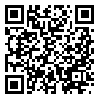Volume 25 - Supplementary
J Birjand Univ Med Sci. 2018, 25 - Supplementary: 68-75 |
Back to browse issues page
Department of Curriculum Development,Faculty of Education and Psychology, Allameh Tabataba`e University,Tehran,Iran , khosravi12m@yahoo.com
Abstract: (5304 Views)
Background and Aim:One of the most important goals of higher education systems is to create creativity and innovation in students, and the curriculum sphere, as the heart of the educational system, can be effective in formulating and implementing this notion. The purpose of this study was to study the factors influencing the acceptance of curriculum innovations in the Iranian higher education system.
Materials and Methods: This is a descriptive-analytic study. The research population comprised of all faculty members in the Tehran-based universities. Given the number of indicators covered in the study, the sample size was estimated to be 174 people who were selected via non-random sampling method. Data were collected by a 95-item researcher-made questionnaire. The Validity of the questionnaire was confirmed by experts and the reliability of the questionnaire was 0.83 using Cronbach's alpha method. SPSS16 and PLS software were used to analyze the data. Correlation and path analysis were used at the significant level of 0.05.
Results: The results showed that the curriculum culture, macro-environment policy, learners’ characteristics, innovation characteristics, facilitators of and barriers to innovation in higher education curriculum have a significant effect (p <0.05).
Conclusion: Therefore, understanding the factors influencing the implementation of innovations in the curriculum can be used as a tool for better planning in the process of implementing educational innovations.
Materials and Methods: This is a descriptive-analytic study. The research population comprised of all faculty members in the Tehran-based universities. Given the number of indicators covered in the study, the sample size was estimated to be 174 people who were selected via non-random sampling method. Data were collected by a 95-item researcher-made questionnaire. The Validity of the questionnaire was confirmed by experts and the reliability of the questionnaire was 0.83 using Cronbach's alpha method. SPSS16 and PLS software were used to analyze the data. Correlation and path analysis were used at the significant level of 0.05.
Results: The results showed that the curriculum culture, macro-environment policy, learners’ characteristics, innovation characteristics, facilitators of and barriers to innovation in higher education curriculum have a significant effect (p <0.05).
Conclusion: Therefore, understanding the factors influencing the implementation of innovations in the curriculum can be used as a tool for better planning in the process of implementing educational innovations.
Type of Study: Original Article |
Subject:
Medical Education
Received: 2018/02/18 | Accepted: 2018/04/28 | ePublished: 2018/09/5
Received: 2018/02/18 | Accepted: 2018/04/28 | ePublished: 2018/09/5
| Rights and permissions | |
 |
This work is licensed under a Creative Commons Attribution-NonCommercial 4.0 International License. |

